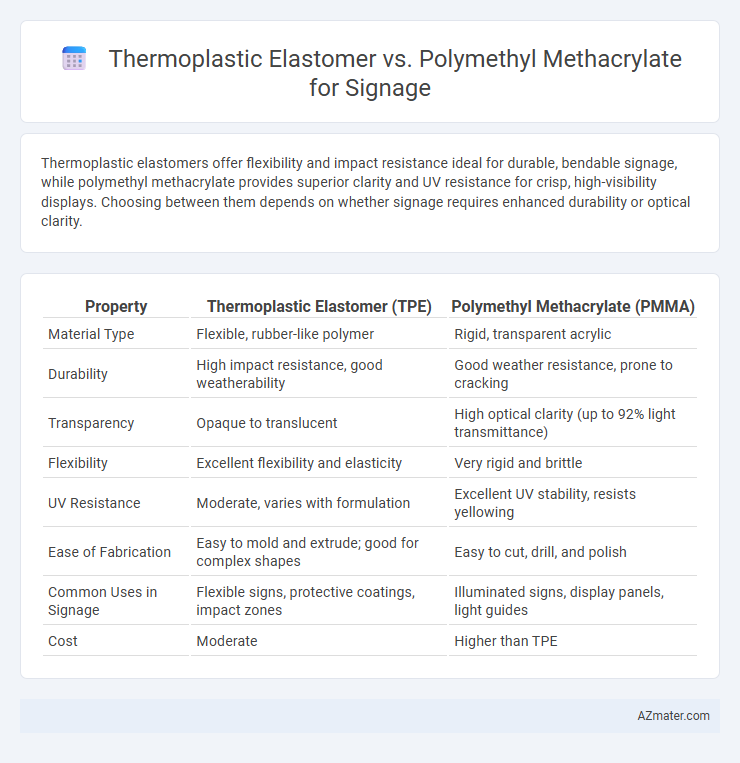Thermoplastic elastomers offer flexibility and impact resistance ideal for durable, bendable signage, while polymethyl methacrylate provides superior clarity and UV resistance for crisp, high-visibility displays. Choosing between them depends on whether signage requires enhanced durability or optical clarity.
Table of Comparison
| Property | Thermoplastic Elastomer (TPE) | Polymethyl Methacrylate (PMMA) |
|---|---|---|
| Material Type | Flexible, rubber-like polymer | Rigid, transparent acrylic |
| Durability | High impact resistance, good weatherability | Good weather resistance, prone to cracking |
| Transparency | Opaque to translucent | High optical clarity (up to 92% light transmittance) |
| Flexibility | Excellent flexibility and elasticity | Very rigid and brittle |
| UV Resistance | Moderate, varies with formulation | Excellent UV stability, resists yellowing |
| Ease of Fabrication | Easy to mold and extrude; good for complex shapes | Easy to cut, drill, and polish |
| Common Uses in Signage | Flexible signs, protective coatings, impact zones | Illuminated signs, display panels, light guides |
| Cost | Moderate | Higher than TPE |
Understanding Thermoplastic Elastomer and Polymethyl Methacrylate
Thermoplastic elastomers (TPE) offer flexibility, impact resistance, and durability, making them ideal for signage requiring bending or outdoor exposure. Polymethyl methacrylate (PMMA), known as acrylic, provides excellent clarity, UV resistance, and weatherability, preferred for high-visibility, rigid signage. Understanding these materials' mechanical properties and environmental stability helps in selecting the best option for specific signage applications.
Material Composition and Properties
Thermoplastic elastomers (TPE) consist of a blend of polymers that exhibit both thermoplastic and elastomeric properties, offering high flexibility, impact resistance, and resilience ideal for signage requiring durability and bendability. Polymethyl methacrylate (PMMA), also known as acrylic, is a rigid, transparent thermoplastic characterized by excellent optical clarity, UV resistance, and weatherability, making it suitable for outdoor signs demanding precision and visual appeal. While TPE provides superior shock absorption and flexibility, PMMA excels in hardness, scratch resistance, and transparency, influencing material choice based on signage application needs.
Durability and Weather Resistance Comparison
Thermoplastic elastomers (TPE) exhibit superior flexibility and impact resistance compared to polymethyl methacrylate (PMMA), making TPE less prone to cracking under stress in signage applications. PMMA offers excellent UV resistance and clarity but tends to become brittle and can yellow over prolonged outdoor exposure, reducing its weather resistance. For long-term durability in harsh weather conditions, TPE's ability to withstand temperature fluctuations and mechanical stress provides a significant advantage over PMMA in signage materials.
Flexibility and Impact Strength in Signage Applications
Thermoplastic elastomers (TPE) offer superior flexibility and high impact strength, making them ideal for signage that requires durable, bendable materials resistant to deformation. Polymethyl methacrylate (PMMA), while providing excellent clarity and weather resistance, is rigid and more prone to cracking under impact, limiting its use in dynamic or high-impact signage environments. For applications where signs are exposed to mechanical stress or require frequent handling, TPE materials ensure longer-lasting performance without sacrificing visual appeal.
Visual Clarity and Aesthetic Appeal
Thermoplastic elastomers offer flexibility and impact resistance, but their visual clarity often falls short compared to polymethyl methacrylate (PMMA), which delivers superior transparency and a glass-like aesthetic ideal for high-visibility signage. PMMA provides excellent light transmission rates of up to 92%, enhancing color vibrancy and sharpness for visually striking displays. The smooth surface and resistance to yellowing make PMMA the preferred choice for maintaining long-term aesthetic appeal in outdoor signage applications.
Cost-Effectiveness and Budget Considerations
Thermoplastic elastomer (TPE) offers superior flexibility and impact resistance at a lower material and fabrication cost compared to polymethyl methacrylate (PMMA), making it ideal for budget-conscious signage projects that require durability. PMMA provides a higher clarity and a more polished aesthetic but involves higher raw material expenses and greater machining costs, impacting overall budget constraints. Evaluating signage needs for durability versus visual appeal helps optimize cost-effectiveness between TPE and PMMA selections.
Printability and Customization Capabilities
Thermoplastic elastomers (TPE) offer superior flexibility and durability, making them ideal for signage that requires frequent handling and outdoor exposure, while providing excellent printability with UV and solvent-based inks. Polymethyl methacrylate (PMMA), commonly known as acrylic, delivers high optical clarity and smooth surfaces, enabling precise digital and screen printing, but is less flexible and more prone to cracking under stress. Customization with TPE allows for molding into diverse shapes and textures, whereas PMMA excels in producing rigid, high-gloss signs with vibrant, detailed graphics.
Installation and Maintenance Factors
Thermoplastic elastomers offer flexible installation options due to their lightweight and impact resistance, enabling easy cutting and shaping on-site, which reduces labor costs and time. In contrast, polymethyl methacrylate requires precise machining and careful handling during installation to prevent cracking, often necessitating specialized tools and professional expertise. Maintenance of thermoplastic elastomers is simplified by their resistance to UV radiation and weathering, whereas polymethyl methacrylate demands regular cleaning with non-abrasive materials to maintain clarity and avoid surface degradation.
Environmental Impact and Sustainability
Thermoplastic elastomers (TPE) offer enhanced recyclability and lower environmental impact due to their ability to be repeatedly melted and reshaped, reducing waste in signage applications. Polymethyl methacrylate (PMMA), while durable and UV resistant, is less sustainable as it is derived from non-renewable petroleum resources and is more challenging to recycle, often ending up in landfills. Choosing TPE for signage supports circular economy goals with reduced carbon footprint and better end-of-life management compared to PMMA.
Choosing the Right Material for Your Signage Needs
Thermoplastic elastomers (TPE) offer flexibility, impact resistance, and weather durability, making them ideal for signage exposed to dynamic environments and requiring resilience. Polymethyl methacrylate (PMMA), known for its high clarity, UV resistance, and rigidity, suits applications demanding a glass-like appearance and long-term outdoor visibility. Selecting between TPE and PMMA depends on priorities such as flexibility versus optical clarity, environmental exposure, and cost-efficiency for signage longevity.

Infographic: Thermoplastic elastomer vs Polymethyl methacrylate for Signage
 azmater.com
azmater.com